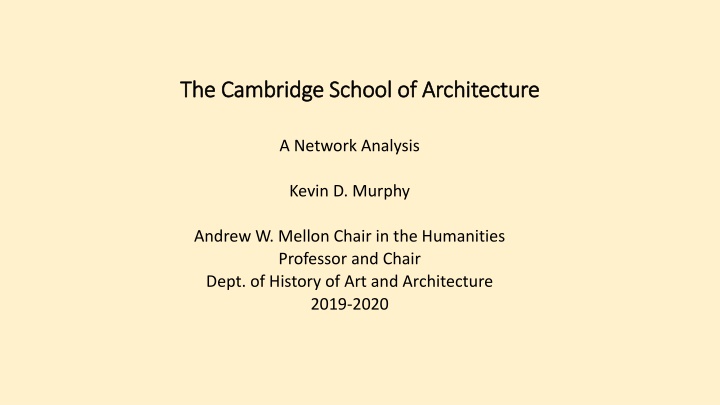
Mapping Women in Architectural Practice: Networks of Success
Explore the impactful role of networks in enabling women to succeed in diverse design fields, as seen through the historical context of the Cambridge School of Architecture. Discover how these connections facilitated opportunities beyond traditional architectural practice, shaping a path for women in American modernism.
Download Presentation

Please find below an Image/Link to download the presentation.
The content on the website is provided AS IS for your information and personal use only. It may not be sold, licensed, or shared on other websites without obtaining consent from the author. If you encounter any issues during the download, it is possible that the publisher has removed the file from their server.
You are allowed to download the files provided on this website for personal or commercial use, subject to the condition that they are used lawfully. All files are the property of their respective owners.
The content on the website is provided AS IS for your information and personal use only. It may not be sold, licensed, or shared on other websites without obtaining consent from the author.
E N D
Presentation Transcript
The Cambridge School of Architecture The Cambridge School of Architecture A Network Analysis Kevin D. Murphy Andrew W. Mellon Chair in the Humanities Professor and Chair Dept. of History of Art and Architecture 2019-2020
Women in Architectural Practice: Pathways in American Modernism Women in Architectural Practice: Pathways in American Modernism This project maps the network of social and professional relationships between the graduates of the Cambridge School of Architecture in Massachusetts which operated from 1915 until the nearby Harvard University architecture program began accepting women, in 1942. While the graduates worked in a variety of fields architecture, landscape architecture, urban planning and housing policy, and so on and designed in a number of styles, a group of them produced early and under-discussed modern designs. In this respect, the most important of the alumnae was Eleanor Raymond (1887-1889, graduated 1916) who remained deeply connected with the school as a trustee and supporter of its graduates. She operated a Boston architecture practice for decades in which she employed many women architects. Together with her life partner, Ethel Power (1881- 1969, also a Cambridge School graduate), the longtime editor of House Beautiful, she was the hub of a spoke of networks that supported women architects as they made their ways in a male-dominated, sexist profession. The Cambridge School of Architecture (c. 1928) from the Annual Bulletin. This project supports the book, co-authored by myself and Dr. Mary Anne Hunting: Women in Architectural Practice: Pathways in American Modernism which is under contract with Princeton University Press.
The Network(s) The Network(s)-- --Objectives: Objectives: We sought to map the relationships between the graduates of the Cambridge School as a means of understanding how those connections enabled women to succeed as they pursued work in a variety of design fields. Our initial impression, after years of archival research, was that women were especially dependent on networks of associations because of the barriers to professional practice they faced. Those networks helped them as they branched out from architectural practice (where they were often unwelcome) to allied fields such as publishing, curating, interior design, retail, and more.
Constructing the Networks: Constructing the Networks: To construct the network analysis and assemble the data, drawn largely from the Annual Bulletin of the Cambridge School, we hired as consultants Dr. Scott Weingart (Carnegie Mellon University) and Dr. Margaret Laster (New York City). Dr. Laster has assembled our data into two spreadsheets (see following slides) showing the people in whom we are interested (segregated into the categories of Primary and Secondary significance) and showing their interactions according to a schema we collectively established.
Networks: People (partial) Networks: People (partial)
Networks: Relationships Networks: Relationships
Mapping the Networks: Mapping the Networks: Dr. Weingart has begun the process of constructing the networks. The first visualization is based on data from the first three volumes of the Cambridge School Annual Bulletin. (See following slide for the preliminary result of the visualization.) Over the course of the following month we will be adding to the database of relationships, based on further mining of the Annual Bulletin and other sources and the visualizations will take shape.
Preliminary Network Visualization: Preliminary Network Visualization:
Conclusions: Conclusions: The network analysis will enable us to visualize the relationships between these women that we intuited were important to them. The visualizations will also show who were the major figures connecting the women to one another, and to male figures in the field. The fellowship enabled me to undertake a kind of analysis which I would not otherwise have been able to pursue. It will be a key foundation on which to build the argument of what we hope will be an important contribution to the fields of architectural history and women s studies.
